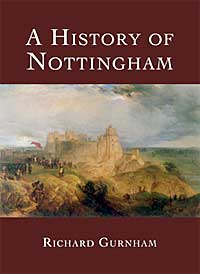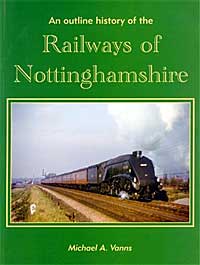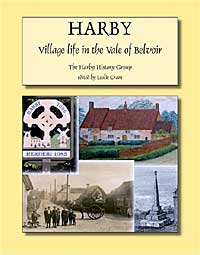Book reviews, Summer 2011
A HISTORY OF NOTTINGHAM
By Richard Gurnham (Phillimore, 2010) ISBN 978-1-86077-658-8

This book is a synthesis of other people’s work, and it contains virtually nothing which cannot be found in The Centenary History of Nottingham (republished in 2006 by Phillimore) or in Nottingham: an illustrated History, by John Beckett and Ken Brand (1997) or Christopher Weir’s Nottingham: a History (2002). There is no claim, nor any attempt to claim, originality (no primary sources are used and no footnotes or references offered), although by contrast with the other books there is a stronger emphasis on politics ( at least in some periods) at the expense of topography. The book tells the story of Nottingham from its murky Anglo-Saxon beginnings through its medieval and early modern history, and on to the great disjunction when framework knitting migrated from London to the East Midlands towards the end of the seventeenth century. From 1670 or so onwards the town grew rapidly, finally bursting through its artificial boundaries following the 1845 Enclosure Act. With the incorporation of the surrounding villages in 1877 and the grant of city status in 1897 it became recognized as one of the leading provincial cities. In the twentieth century it changed again: people moved from the city to the new estates, leaving commercial interests to take over the heart of the city, and industry moved on from textiles to a strong commitment to public service.
At £20 this is not a cheap book, and the small typeface and the rather uninspiring collection of pictures, all reproduced in grainy black and white, does not make it leap off the shelf at you. Pity, because this is generally a good series from Phillimore, and they obviously saw it as filling a gap in the market for a medium length book about Nottingham.
John Beckett
AN OUTLINE HISTORY OF THE RAILWAYS OF NOTTINGHAMSHIRE
By Michael A. Vanns (Notts County Council 2010) ISBN 978-0-902751-67-5

Michael Vanns’ new publication is a welcome addition to those works that he has already had published on railways. The book traces the history of railways in Nottinghamshire in a lucid, logical and well set out manner. The book is well structured with chapters allocated to each of the relevant pre-grouping companies, a chapter detailing the postgrouping companies, the LMSR and the LNER, and subsequent chapters dealing with British Railways and Privatization. There is a comprehensive bibliography for readers wishing to indulge in further study and three sets of tables, one of which highlights the differences in through passenger traffic within the county between the years 1910 and 2010. The book is also well illustrated with over 80 photographs, maps and engravings.
The history of railways in Nottinghamshire is inextricably linked to that of the coal industry and this book makes that clear. The wealth of the Midland Railway in particular was based on the vast tonnage of coal that it transported both within the county and to destinations further afield. The Victorian rail network was constructed primarily to transport freight: passenger traffic was an additional bonus (though now with the virtual demise of freight on railways the reverse is the case!). Pregrouping railway history is a classic example of Victorian laissez-faire economics and, once again this is highlighted in the book with examples of the lengths that the private companies would go to in order to protect their own markets, evidenced by the multiplicity of contending lines built to serve the same locality. To illustrate this, the famous episode of the Midland Railway’s ‘high jacking’ of a Great Northern engine in Nottingham station is referred to.
There are, however, one or two notable omissions from the early chapters of the book. Firstly, the significance of the waggonway at Wollaton in 1603/4 is only mentioned in passing ( and then erroneously states that it ran from Wollaton to Nottingham when it actually ran for approximately two miles from Strelley to Wollaton Lane end. This railway is considered to be the earliest known overland railway to run in England, albeit in a very embryonic form. Secondly, there is no mention of the Newark Brake Trials of 1875. These were a significant event in railway history and the fact that they occurred within the county is surely worthy of mention. Parliament had become concerned with the number and type of railway accidents that were occurring all to frequently on the rail network. An adequate and satisfactory system of braking trains was deemed essential for improving railway safety. Different railway companies employed systems to brake their trains, usually air, vacuum or chain operated. Often, these systems were not compatible with the systems used by rival companies and this could cause problems with the day-to-day running of trains. In an unprecedented degree of co-operation seven companies took part in a series of braking trials on a stretch of Midland Railway line between Lowdham and Rolleston Junction on the Nottingham to Lincoln line to see which system was the most effective. These tests took place on the 9th and 10th June 1875 and were an important step on the path to greater safety on the railway system. (The Midland Railway train proved to have the most effective braking system).
Chapters 6 and 7, whilst containing much interesting historical information, also contain some statements which some readers might find open to debate. To state that the dividing up of British Rail into business ‘sectors’; in 1982 was a ‘positive’ milestone for the railways of Nottinghamshire is one such instance and is certainly open to argument. What is certain is that with the new system of franchises on the railway the sole motive for any operating company is profit, often obtained thanks to subsidies that British Railways and later British Rail could only dream of. Even with these subsidies GNER and Midland Mainline still lost their franchises. Currently the Government subsidizes Network Rail to the tune of approximately £5 billion annually. It may be true to state that services have improved with more trains operating but it is very questionable whether the quality of service on those trains is satisfactory with overcrowding a constant problem, ( a result of train operators having to hire every carriage that they use, and it is more profitable to run smaller trains overcrowded than to run trains with surplus capacity). The old HSTs (now over 30 years old and introduced by British Rail) still provide the most capacious trains between Nottingham and London.
Michael Vanns’ book merits a wide readership from the general public through to the local historian and rail enthusiast. Thanks should also go to Nottinghamshire County Council for supporting the venture.
Nigel Morley
(The book costs £7.50, is A4 in size, and can be bought from all major libraries in the county and from Nottinghamshire Archives or by post by sending a cheque payable to Nottinghamshire County Council, for £10.50 which includes p&p to Libraries, Archives and Information, Communities Department, 4th Floor, County Hall, West Bridgford, Nottingham, NG2 7QP).
HARBY – VILLAGE LIFE IN THE VALE OF BELVOIR
The Harby History Group 2010, ISBN 978-0-9567515-0-8

This book provides an interesting read and is a good example of what can be achieved by a dedicated and enthusiastic history group. Following their research and writing of the book, the group has ensured that photographs, diaries, personal recollections and poems are preserved for future generations in the Record Office for Leicestershire and Rutland.
The book tells the story of Harby from Domesday, continuing through the ages until 1975, and is illustrated with maps, illustrations and photographs. Trade Directories provide information about the village and the people. Topics include: Harby at Work, War Years, the School, Church and Chapel, Women’s Institute, and a variety of social activities. There are some surprising and interesting observations of historic and local events recorded in diaries and personal recollections.
Thomas Gee’s map of 1790, a 1793 Enclosure Award map, and an interpretation of the 1871 census, help to provide an initial overview of Harby, but much of the content is more recent.
It is noted that although water pumps and wells were not identified on a 1930 map, they were the only supply of water in the village. People recall that, as late as 1944, mains water and electricity were not available to everyone. Tin baths were still in widespread use and there are nostalgic accounts of Monday washdays with fires lit under the copper and blue bags being added to brighten the whites.
Other villagers’ memories from the 1940s include a Sunday School treat of riding on canal barges from Langar bridge, fields of cowslips, haymaking in the summer and riding on the hay wagon drinking bottles of Vimto. Of particular interest are four volumes of diaries written by the village blacksmith, which span the years 1915 and 1922 to January 1931. The entries are varied and an attractive combination of local and occasional international events, such as an account of shoeing eight horses and reflections on the torpedoing of the SS Lusitania in May 1915.
Many other aspects of the village are mentioned. The Grantham canal receives its own section and there is a fascinating article on cheese making and the famous Harby stiltons. Healthcare during the 1930s and 40s is covered in some detail, along with the decline in the number of farms from the 1950s and the duties of the village policeman. Railway enthusiasts will enjoy a photograph of Harby and Stathern station taken in 1916 and a nostalgic watercolour of the last goods train crossing the bridge on the Stathern Lane in 1964.
War memorials often act as one of the focal points of village life and Harby is no exception. The book explains that the shaft and base of the war memorial cross were originally part of the ancient village cross dismantled by Cromwell’s Roundheads. The base of the cross now includes a list of nineteen men who died in the First World War and eighty-one names of the men who enlisted, fought and survived. The cross also includes two men who died in the Second World war.
A memory of an airman from 207 Squadron, RAF Langar, befriended by a Harby family during the Second World War, is particularly moving. The family heard the massive explosion of Lancaster O-Orange crashing and later learned that the airman was one of the four crew members whose bodies were never found. A longstanding friendship with the family of the airman was subsequently forged. Personal memories of Langar airfield provide a detailed account. In addition to aircraft manufacturer AV Roe and RAF 207 Squadron, the airfield was home to the American 9th Air Force and the Canadian Royal Air Force. The WI helped to keep spirits high during the war years with 2,128 lbs of jam being made and distributed!
Histories of the church and chapel are given in detail with engravings and photographs.
The social aspects of Harby life are included and provided enjoyment to the reader. An amusing episode occurred in 1937 at the Coronation Firework display when one attendant selected the fireworks, contained in a washing basket, by naked flame. Spectators ran for cover and the display was over within three minutes!
The book has a comprehensive contents page and useful fact files of dates and happenings together with notes about the contributors. A list of sources is provided together with an index of illustrations and a general index. In summary, this is a valuable and eclectic insight into the minutiae of life in a village and it provides a good pattern for other historians to follow.
Colin Pendleton
Ed’s note: it might seem odd to review a book relating to a Leicestershire village but I defend it on two counts: firstly, Harby is a border village between Nottinghamshire and Leicestershire and the book provides the opportunity for a researcher to have an interesting comparison between a Leicestershire village and an adjacent Nottinghamshire village. Secondly, the book’s editor is Leslie Cram, a member of our Society and who only recently stepped down from the role of Programme Secretary.